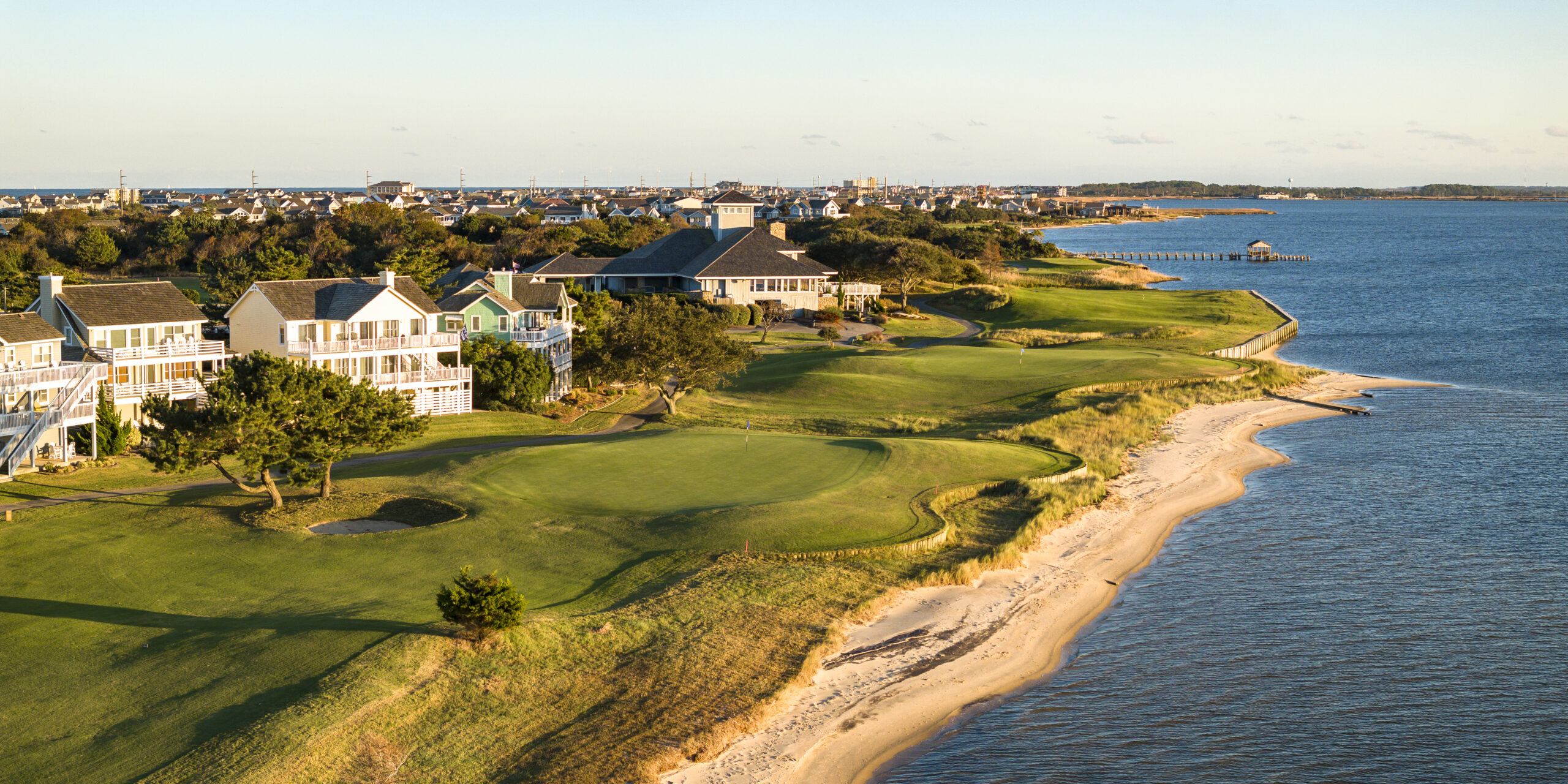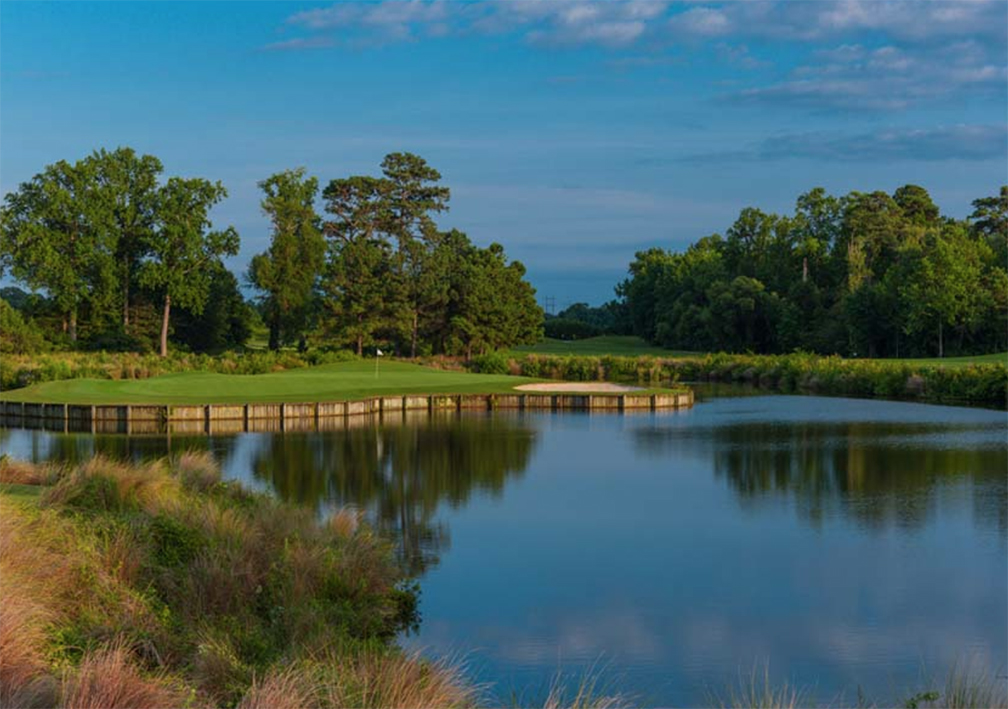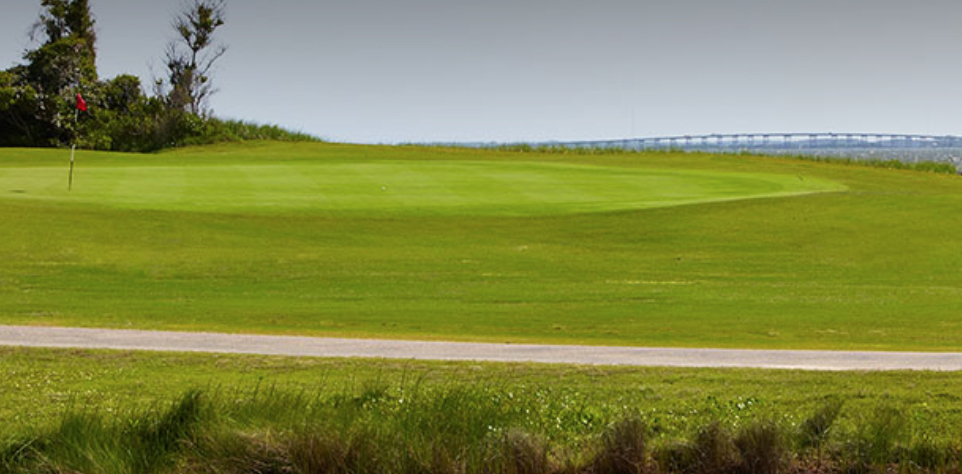
The Outer Banks of North Carolina, a nearly 200-mile strand of narrow barrier islands separating the Atlantic Ocean from the mainland, are known for their temperate climate, wide expanse of open beachfront and as the site of the first flight in a powered heavier-than-air vehicle by the Wright brothers at Kill Devil Hills near the town of Kitty Hawk in 1903.
Romance book and movie fans will also recognize the region as the locale for the novel and film “Nights in Rodanthe,” which glorified the stark and isolated beauty of the islands and their famed wild beach horses.
For our purposes, the Outer Banks (abbreviated OBX) and affiliated mainland areas have a slew of great golf courses fashioned out of sand and wind-swept terrain on the islands themselves or through the mainland forests that grow virtually to the very edge of the sound between the island and coast.
These four courses are among the best in the region and give a sampling of what the destination has to offer.

The Carolina Club
Kilmarlic is not for the timid
Kilmarlic Golf Club, set in Harbinger among 605 acres of maritime forest and sprawling wetlands, was designed by Tom Steele and opened in 2002. It features mostly wide corridors through canopies of giant oak, pine and dogwood along a route that measures just 6,550 yards from the back set of five tees and is a par-72.
The course, which runs just west of Albemarle Sound, is named after a local piece of lore. It’s said that in the 1700s a ship laden with casks of whiskey sailed out of Kilmarnock, Scotland, ran aground on the nearby Carolina coast. The locals salvaged the cargo after it washed ashore and celebrated their good fortune, honoring the occasion by naming the place Kilmarlic.
The scenic layout offers a delightful mixture of risk-reward par-5s, long and short pa- 4s and par 3s that stretch as long as 213 yards. There are plenty of ponds and bunkers to navigate as well, confirming its stout reputation.
Kilmarlic’s demanding final stretch includes the 385-yard par-4 15th; the longest three-shotter on the property via the 565-yard 16th, the heftiest par-3 at the 213-yard 17th; and the reachable-in-two 514-yard, par-5 closer that curves around a lake lurking for golf balls hit offline to the left.
More than 300 acres of Kilmarlic have been designated a nature preserve and enhance the natural beauty and character of the landscape. Wild turkey, deer, otters, and geese populate the course along with golfers.
It’s a tremendous tournament course with a little bit of everything, concluding with a back nine with three par-5s, a drivable par-4 and trouble left and right on most every hole. There are birdies and bogeys available on every swing, especially down the stretch. The track is a challenge for every level of golfer and a joy to play from start to finish.

Kilmarlic
Currituck Club is a Rees Jones favorite
When Rees Jones designed the Currituck Club in 1996, he knew that the wind would always be a dynamic to contend with. The course is laid out on a four-mile ribbon of land toward the northern end of the Outer Banks, near the village of Corolla, with the Atlantic Ocean a quarter mile to the east and Currituck Sound bordering it to the west.
Such an environment dictated a layout that allows the golfer space to hit the ball and keep it in play, even if the wind is pushing it sideways. Fortunately, Jones had enough space to work, and he produced one of his favorite creations.
The Currituck Club, at 6,885 yards from the back set of four tees is manageable for the average player, providing that the golfer plays from the appropriate set of tees. The course boasts some remarkably diverse coastal terrain, including sand dunes, wetlands, maritime forests, and Sound-side shoreline.
It shares the landscape with deer, osprey, geese, and turtles. Golfers might even catch a glimpse of an eagle soaring overhead.
The layout offers a links feel reminiscent of traditional Scottish courses, especially the seventh through the ninth, which border Currituck Sound. The course finishes on the Sound with a scenic stretch that allows the player to get a shot or two back.
The natural terrain of the Outer Banks includes some enormous sand hills. The home half at the Currituck Club is laid out in part over some of these towering mounds and Jones takes great lengths to make sure he gets the most out of what Mother Nature provided.
The fairway at the 454-yard 12th, a dogleg-right par-4, runs uphill to a green nestled in a ridge of dunes. The tee on the 578-yard par-5 13th is elevated well above the fairway – these two holes are among the toughest at the Currituck Club. The par-3 15th runs along the Sound and is quite a sight; try to focus and take one more club on this 174-yard head-turner.
There isn’t a bad hole at the Currituck Club. Jones has fashioned a track that requires strategic awareness, accuracy, and steady nerves, particularly from the back tees.
Even with its benign start and finish, the Currituck Club can be extremely difficult. The course has been rated as one of the 10 Best New Places You Can Play by Golf magazine and one of the Top 25 Courses in North Carolina by Golf Digest.

Currituck Club
Nags Head Golf Links puts premium on accuracy
Crafted by Bob Moore, Nags Head Golf Links is carded at just 6,126 yards, plays hard along the inner waterway on the southern end of the Outer Banks, where the breezes off waters create a unique golfing experience that changes from shot to shot.
The narrow footprint is buffeted by gusts from both the Atlantic and the Sound; we guarantee you’ll never play a tougher “short” course anywhere.
Nags Head Golf Links places a premium on accuracy over length as pinching dunes and shrubs offer a narrow target on many of the tees as Moore deliberately designed the landing areas to feel restricted to demand accuracy. It has pushed-up greens, mounds, and ponds in just the right places to get your attention, and great care must be taken to account for the hidden hazards crossing the landing areas, which force layup shots.
It’s refreshing to play a course that makes you play green to tee rather than bomb and gouge. off the tee. The subtleties of Nags Head Golf Links’ design offers a diverse variety of shot demands and plenty of risk/reward opportunities.
Described as “the cruelest” of Nags Head’s five par-3s, the 15th is a 221-yard brute on which a sudden gust of wind can affect your shot enough to push it into a pond on the left or possibly the Roanoke Sound on the right.
From there, a par-4, par-3, par-5 finish next to waters that constantly slap onto the land will have you convinced you are playing links golf in Scotland or Ireland. With all the wind, water, and wetlands that come into play at Nags Head the course has a magical way of changing almost by the minute.

Nags Head
The Carolina Club is a great place to start, or finish, a trip to the Outer Banks
There is something to be said for being first – or last. Though the Carolina Club is actually one of the newest courses in the OBX golf market, its prime location in Grandy on the North Carolina mainland makes it an easy choice for those coming into or on their way out of the Outer Banks.
The Carolina Club was fashioned by Russell Breeden and Moore and is one of the longest courses in the area, stretching to 6,697 yards. The course, opened in 1998, has an island green, a hole-long bunker and plenty of water to provide players with all kinds of challenges. It was built on flat terrain, but the fairways do feature some slight mounding and contour.
A creative mix of three par-3s and three par-5s characterize the front nine with the sixth and seventh holes forming a unique coupling. The par-5 sixth features marshland stretching across the fairway while the 159-yard seventh hole showcases the area’s premiere island green.
The closing stretch of pars 4-3-5 is also thrilling with the 207-yard 17th serving as The Carolina Club’s arguable signature hole with its stadium-like setting.
The routing winds through wetlands and wooded areas. The Carolina Club plays tighter than it looks, with strong winds periodically coming into play, but five sets of tees allow you to match your game to the challenge.

Carolina Club

